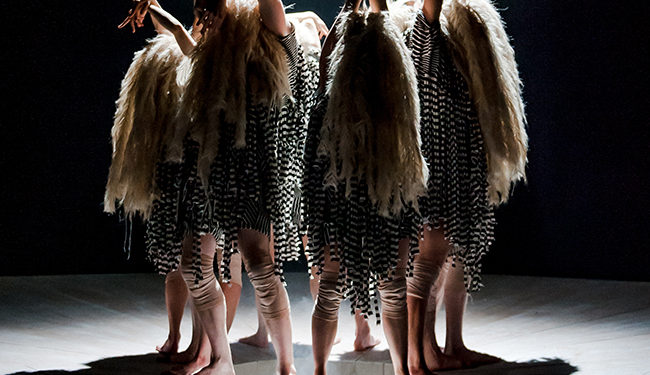Another memorable dance, a theatre production that I have had the pleasure to see would be YAMA by Scottish Dance Theatre from Dundee, a production that explores the mythology associated and inspired by the pagan and animist rituals in the mountains of Tohoku, Japan. Created by the dancers of Scottish Dance Theatre YAMA creates and gathers great energy and has a clear and layered structure that is I guess, easily distinguished. The choreographer Damien Jalet has been doing some fantastic productions in the last 15 years, including Babel (Laurence Olivier award 2011) and work with Akram Khan, Sidi Larbi Cherkaoui, and the radical re-staging of Bolero with Marina Abramovic at the Paris Opera.
As I have seen this piece only, I can say that is truly fantastic and hypnotic choreography. It shows off the exceptional group of dancers, managing a very small, tiny stage just fantastically (at least that was the case in my perception). Even if it happened in my city 2016 (premiered in the UK even before) the piece stayed under my skin, in memory as one of the truly challenging ones, almost terrifying dance virtuoso production.
According to the Japanese animism theory, animism perceives all things—animals, plants, rocks, rivers, weather, human handiwork, words—as animated and alive as used in the anthropology of religion as a term for the belief system of indigenous people all over the world, which is in this case by Japanese animist rituals. It seems that animism is good to contemplate, especially in contrast to the relatively more recent development of organized religion today, also to perceive in a social context and primal fear context.
I remember, besides vivid costumes of dancers on the stage, how quickly they disappear and elegantly appear through the stage floor. It may bring up many things in the viewer’s head, of course, that is depending on the viewer. Although each culture has its own different mythologies and rituals, animism is said to describe the most common, foundational thread of indigenous peoples from the’ “spiritual” or “supernatural” perspectives. The animistic perspective is so widely held or used today in modern art and like ancient people artists do not even have an exact word in the languages that correspond appropriately to it. It is strictly attached to a mind track today, that is in our contemporary world. In the anthropological construct, it focused on the worship of nature spirits, angry deities, or the well-being of ancestors. Such appears to have been the case in both countries, Britain or Japan, also many other cultures too.
But if you have got just a grip of interest for the subject I just came across a very interesting cultural study by Dr John Dougill, from Ryukoku University, who wrote SHINTO AND PAGANISM: PRIMAL RELIGION IN JAPAN AND BRITAIN. Check it out at
And I am quoting Gougill “Because of the lack of documentation, much of the religious practice carried out in ancient times before the arrival of Buddhism and Christianity has had to be surmised from archaeological remains. As elsewhere in the world, it’s supposed that beliefs formed around animist and ancestral spirits, accessed by shamans. Certainly, something along these lines appears to have happened in Japan, with scholars disputing which came first: ancestral or animist spirits“
And I say what all this has to do with contemporary dance production of the Scottish Dance Company from Dundee? Well, I am not sure. Maybe a lot! Scottish literature or folk is very often related to paganism. The Japanese tradition and the British tradition of paganism are at a first glance very different. Both traditions worship different gods in different ways. Both have different concepts of the afterlife. It appears that the Japanese one, is also recognized as mainstream and, there is no easy equivalent or apparent similarities with the British or Christian paganism in general.
Belgrade Dance Festival
www.belgradedancefestival.com


